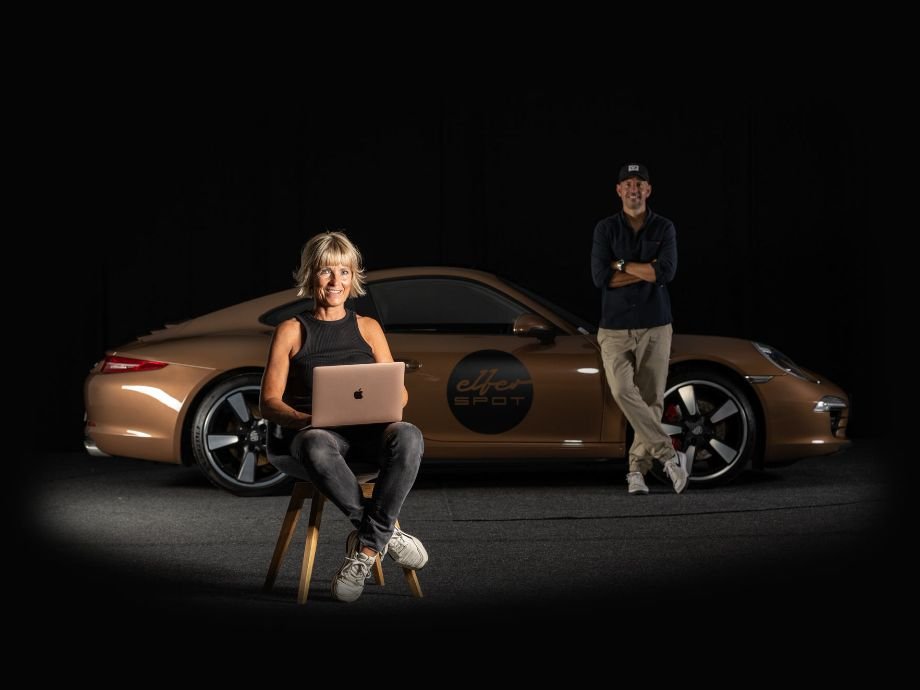Commonly misunderstood that Porsche simply could not afford to give four cars to the United States for their crash testing requirements, they had instead saved on development costs designing and testing to European safety standards only. Nevertheless, the 959 was not lost on U.S. enthusiasts and collectors and there were some efforts to import a modified Sport into the U.S. for track use only.
The Sport saw a 100 kg weight loss over the Komfort, although mechanically the cars were identical. A factory power upgraded with larger turbochargers and revised internals was available that boosted power by 70bhp to 520 bhp. The exceedingly complex suspension setup was discarded in favour of more conventional coil-over setup. The interior was pared back too; air-conditioning was removed, wind up windows installed, radio deleted and rear seats omitted along with central locking and even the passenger wing mirror.
The interior gained a full leather-wrapped roll-cage, with the seats now revised and in cloth with four-point racing harnesses. All 959 Sport were completed to the exact same specification with just the colour being left to choice; Guards Red or Grand Prix White. Just 7 Rest of World 959 Sport examples were completed in 1987 with 1 further car in 1989. All of the 29 USA examples were completed in 1988.
This example has been earmarked for delivery to Texan Le Mans entrant Jack Griffin, who’s unlikely friendship forged over a tennis match with a former Porsche Motorsport Director had seen him send a $60,000 deposit by cheque to Stuttgart. However when the US Environmental Protection Agency rejected the Sport as track-only sportscar, Porsche sent back his refund.
Delivered through the Racing Department in Weissach, the car was sold to Italy in December of 1989, first registered in the name of company Effe Uno SpA of Bolzano. The business was operated by Pierluigi Rindi, a successful businessman in the textiles industry. Rindi would retain the car for 10 years before sale to Bergamo. In 1999, the car was registered to significant construction holding company. Keen Porsche lovers, the 959 joined a garage including their Mille Miglia entrant 356. The family would retain the car until June of 2014 when it was exported to Germany.
Purchased by the current owner in September of 2014, the 959 was shortly thereafter returned to its Stuttgart home for a comprehensive overhaul. Purchased with just 16,700 miles from new, the current custodian requested Porsche Classic carry out a thorough inspection ahead of remedial works.
With a worklist outlined, Porsche Classic overhauled the 959 at a cost of just under €200,000, of which a quarter was spent on the engine alone. At the time of the overhaul, this example received the Porsche factory power upgrade boosting output by 70bhp to just over 520bhp. Porsche Classic are presently overbooked for the Carrera GT and 918 recomissioning service and cannot accept any further restorative works until 2030!
Upon completion in 2017, the 959 Sport made its way to Hong Kong to reside within a prominent global collection. More recently this example has made its way to the UK, undergoing UK registration in 2022. Recent servicing has been carried out exclusively by Porsche Reading with the 959 receiving a minor service in October 2024.
Today this 959 Sport presents superbly. Having been cared without consideration for expense and benefitting from a complete overhaul with Porsche Classic, this example has since been carefully stored and used sparingly. This 959 Sport will undergo a fresh service by Porsche Reading in March 2025 and is available to view at our showrooms outside London immediately.
- 1 of just 29 Sport examples destined for the USA
- Guards Red over Grey Cloth interior
- 100 kg lighter than a Komfort
- Thorough overhaul by Porsche Classic in 2017 with just 800 miles since
- No capacity for future restoration work by Porsche Classic until 2030
- Serviced by Porsche Reading in October 2024
- 520 hp Porsche factory power upgrade
- Resided in Italy for over 25 years
The stakes couldn’t have been higher. The technological advancements in the 1980s through the developed use of turbocharging saw motorsport and road cars catapult forward in terms of pace. With the race to 200mph in full swing, road and race cars alike saw power jump into the high 300s, 400s and beyond. After the launch and success of Ferrari’s 288 GTO in 1984 with innovative, lightweight composite body panelling and a turbocharged powerplant offering both high power and torque, every year brought faster and faster variants.
When Ferrari started production of the 288 GTO in 1984, Porsche had been in Africa with its 953. A naturally aspirated 911 with a manually adjustable four-wheel-drive system, designed specifically for the task but as a testbed for various systems, the car took victory at the Paris-Dakar rally. In terms of the technological race, Ferrari’s GTO was virtually stationary compared to Porsche’s efforts.
This victory at Dakar marked a significant achievement for Porsche. The future of the 911 was in doubt already with the creation of the 924, 944 and 928 suggesting Porsche would ditch its roots in favour of a more traditional front-engined, rear-wheel-drive layout. Despite an internal battle over the future of front-engined over rear-engined layout, the win enabled chief engineer Helmuth Bott, to continue the development of a secret, ‘Super 911’. If it were to be the last ‘911’ instalment, it needed to conquer all; on the road, on the race track and even the rally scene too.
In the wake of the 1973 OPEC oil embargo and ensuing crisis, which lead to slowing down of technical development; motorsport regulations were changed to form Group B. This ‘no-limits’ motorsport was created to once more inspire technological innovation in all aspects of automotive research and development. Porsche were keen to get in the action, developing the 953 into the 959 with the addition of twin turbochargers; the FIA regulation stipulated 200 production cars would be needed to comply. The ‘Gruppe B’ concept was first shown in 1983, the 959 prototypes were built in 1985 and the first customer cars weren’t shipped until 1987. This meant that after Henri Toivonen and Sergio Cresta’s fatal crash at the 1986 Tour de Corse, by the time the cars were in customers hands, the era of Group B was over.
Whilst the 959 has long stood as Porsche’s response to Ferrari’s 288 GTO, the original supercar and arriving two years before Ferrari’s iconic F40, it was a very German approach to speed. Unlike the 288, it introduced technological features that were unheard of in the automotive market and provided an excellent platform for Porsche to prove their engineering mettle. In addition to its world-beating performance, the 959 was not only very in keeping with the marque’s design language, but most importantly it was usable on a day-to-day basis.
Bott had earmarked 29 911 Turbo 3.3s to form the basis of the 959 prototype and pre-production cars. The engine shared very little with the 930’s turbocharged 3.3-litre flat-six. Instead it was more closely related to that of the 956 & 962 race cars – water cooled cylinder heads and dual, sequential turbochargers. An extensive array of motorsport-grade parts saw the 959 benefit from titanium con rods, forged alloy pistons and Nikasil-lined cylinders.
Powered by an all-alloy 2.85-litre flat-six, the 959 generated a peak power output of 450hp.In ‘Komfort’ specification, this was already 55bhp more than the 288’s 394bhp. In ‘Sport’ trim, the 959 produced 510hp, or over 100 bhp more than the Ferrari. Whilst the Komfort was good for 197mph, Porsche claimed the Sport would eclipse that speed by just 1 mph. True to form, that claim was rather conservative and in reality, the Sport would reach 211mph.
The intricate four-wheel-drive system featured a complex computer-controlled torque split, helping deploy its power and resulting in a 0-60 sprint of just 3.9 seconds. The 959 was a technological tour-de-force; ABS brakes, tyre pressure sensors, adjustable ride height, hollow-spoke magnesium wheels and a six-speed (5+1) gearbox. This was all offered with the expected Porsche luxuries-not least a totally usable Porsche interior. These innovations would later become mainstays in the automotive industry, later showing that Porsche’s engineers were years ahead of their time when developing the 959.
The 959 was built using the standard 911’s galvanized steel body shell but with composite Kevlar reinforced plastic wings, rocker covers, roof panel, and an aluminium bonnet and door skins. Compared to Porsche’s other ventures in the 1980s, particular attention was paid to aerodynamic efficiency in the 959, including a flat bottom, resulting in a 0.31 coefficient of drag (compared to the same year 911 Turbo, which scored a 0.40 Cd).
The transmission had six forward gears, although at the time Porsche did not have a homologated ‘6-speed’. Instead the gearbox in the 959 was a more traditional 5-speed, with an additional low range 1st gear. Each wheel received ventilated disc brakes with hydraulic assist and ABS. The transaxle tube included Porsche’s PSK variable-centre differential, which managed the torque divisions between the front and rear axle. A second PSK was fitted in the rear axle to work as a form of limited-slip differential. This setup allowed the driver to adapt to road conditions by selecting between ‘traction,’ ‘ice and snow,’ ‘wet’ and ‘dry’ settings. The 959 even featured the world’s first run flat tyres, Bridgestone’ RE71 Denloc.



































